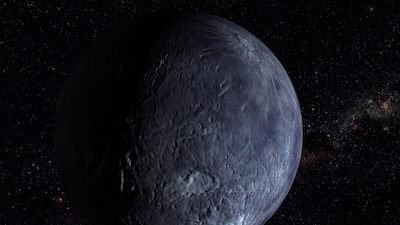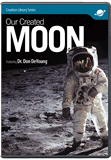
The “Mini-Moon” 2020 CD3
Discover how a new “mini-moon” orbits the earth, how it compares with the primary moon, where it’s going, and what is the relevance for Christians.
A Moon Is Born!
In late February, there were press accounts of a new “mini-moon” orbiting earth. Discovered in mid-February, this object received the designation 2020 CD3 (if you are curious as to what this name means, please see this article). Many people are fascinated with 2020 CD3 and naturally have questions about it. For instance, you may wonder if we can go outside and see 2020 CD3 like we can see the moon. The answer to that question is simple: No. 2020 CD3 is so faint that it taxes the abilities of the largest telescopes in the world to photograph it. The reason that 2020 CD3 is so faint is that it is very small, about the size of a small car (compare that to the moon, which is 2,000 miles across).
More Questions
The gravitational force of the sun on the moon is about twice the gravitational force of the earth on the moon. Therefore, the moon primarily orbits the sun.
The answers to other questions about 2020 CD3 are not so simple. For instance, we are certain that 2020 CD3 hasn’t been orbiting the earth for very long, and it likely won’t orbit the earth for much longer, but we’re not so certain when it began orbiting the earth and when it will stop. Technically, like the moon, 2020 CD3 orbits the sun, not the earth. “What,” you may ask, “the moon orbits the sun and not the earth?” Yes. The gravitational force of the sun on the moon is about twice the gravitational force of the earth on the moon. Therefore, the moon primarily orbits the sun. Having nearly identical orbits around the sun, both the earth and the moon are in freefall around the sun, meaning that they are continually falling under the influence of the sun’s gravity as they orbit. In the (freefalling) frame of reference of orbiting the sun once per year, to a good approximation we can ignore the sun’s force of gravity.
In this frame of reference, the gravity of the earth and the moon are free to act on one another. Since the earth has 81 times more mass than the moon, the moon largely orbits the earth, but the earth also orbits the moon. Both the earth and the moon orbit around a point called the barycenter,1 the center of mass of the earth-moon system. The moon’s center of mass is about 243,000 miles from the barycenter, but the earth’s center of mass is only 3,000 miles from the barycenter (243,000/3,000 = 81). Since the earth’s diameter is 4,000 miles, the barycenter lies inside the earth. But make no mistake—as the moon orbits the earth each month, the earth also orbits the moon (if only just a little bit).
2020 CD3’s orbit around the sun is very similar to that of the earth. 2020 CD3’s orbit is nearly circular, though slightly less circular than earth’s orbit is.2 The average distance of 2020 CD3 from the sun is slightly greater than the earth’s orbital distance, so the orbital period of 2020 CD3 is about two weeks longer than a year. The orbit of 2020 CD3 is inclined less than a degree to the earth’s orbit. 2020 CD3 is just one example of near-earth asteroids, small solar system objects with orbits very close to earth’s orbit around the sun. Near-earth asteroids are of interest because of their possibility of collisions with the earth.
All Good Things Must Come to an End
With its orbit around the sun similar to the earth and the moon, 2020 CD3 is in free fall around the sun, along with the earth and the moon.
With its orbit around the sun similar to the earth and the moon, 2020 CD3 is in free fall around the sun, along with the earth and the moon. As with the earth and the moon, to a good approximation we ignore the effect of the sun’s gravity in this frame of reference. Typically, the orbit of 2020 CD3 caries it closest to earth (perigee) at about 48,000 miles, while the most distant part of its orbit (apogee) is a little more than a million miles from earth (the moon’s orbit around the earth is far more circular, with an average distance of nearly a quarter million miles). However, to a second approximation, we can’t ignore the sun’s gravity.
The relative orbit of 2020 CD3 with respect to the earth is much more chaotic than the moon’s orbit, and it likely came as close as 8,000 miles from the earth last April. The orbit of 2020 CD3 was computed from observations of its position spanning two weeks. Orbital calculations can be very precise, but there always are slight uncertainties in the observed positions. When the uncertainty in position measurements of 2020 CD3 are added to the chaotic nature of its orbit, the past and future orbital behavior of 2020 CD3 is not well known. Astronomers who have calculated 2020 CD3’s orbit think that it began orbiting the earth in 2016 or 2017. They expect 2020 CD3 to leave earth orbit as early as April 2020, so it may already have escaped earth’s bonds by the time many of you read this. When it does escape the earth, 2020 CD3 will pass close to earth in 2044 and again in 2061.
2020 CD3 had escaped detection in the previous 3–4 years it was orbiting the earth. It is fortuitous that 2020 CD3 was discovered shortly before it left earth orbit, or else we likely would never have learned about its existence. Nor is this the first time that an asteroid was captured by earth. In 1991, astronomers discovered the near-earth asteroid 1991 VG. For about a month in 1992, 1991 VG orbited the earth. Undoubtedly, this sort of thing has happened many times in the past and will continue to do so in the future. The difference is that we now have programs dedicated to the search of near-earth asteroids, so we likely will learn of more of these brief “mini-moons.”
What Does It Matter?
These close interactions with near-earth asteroids don’t have a direct link to origins or the age of the world.
These close interactions with near-earth asteroids don’t have a direct link to origins or the age of the world. However, they do have a connection to an issue that Christians are in tune with. 2020 CD3 was discovered as part of a program to search for near-earth asteroids instituted over concern that a collision with an asteroid could destroy civilization (not that we could do anything to prevent a collision if observations indicated that a devasting collision was imminent). Unlike nonbelievers, Christians know that God is sovereign and is in control. Our world will not end with an asteroid impact (though Revelation 6:12–13 and Revelation 8:8–11 speak of events that some interpret as future asteroid impacts as part of God’s judgement). Rather, this world will end with the consummation of God’s plan for humanity as Jesus Christ victoriously returns to earth (Matthew 24:29–30), followed by a new heaven and a new earth (2 Peter 3:11–13; Revelation 21:1).
Footnotes
- The center of mass of two or more bodies (in this case, the earth and moon) that orbit one another and is the point about which the bodies orbit.
- All orbits are ellipses, but the orbit of the earth is nearly circular.
Recommended Resources

Answers in Genesis is an apologetics ministry, dedicated to helping Christians defend their faith and proclaim the good news of Jesus Christ.
- Customer Service 800.778.3390
- © 2024 Answers in Genesis







